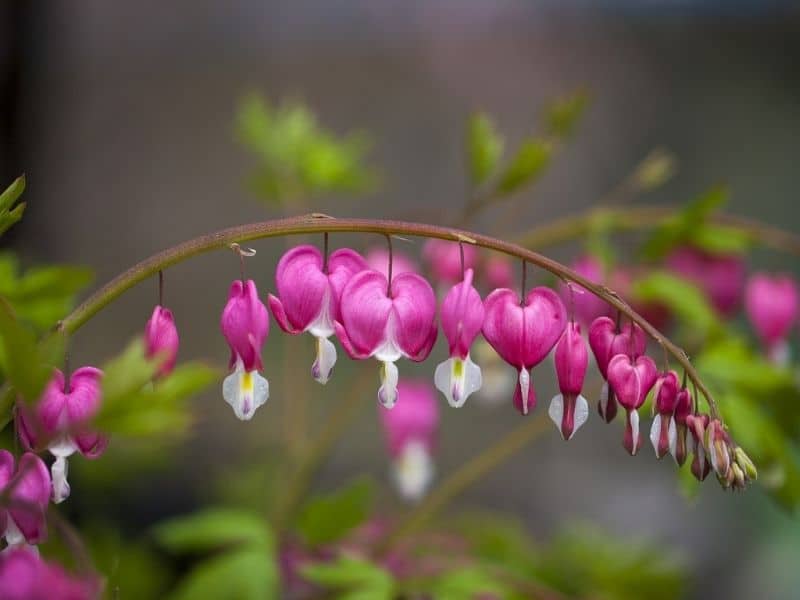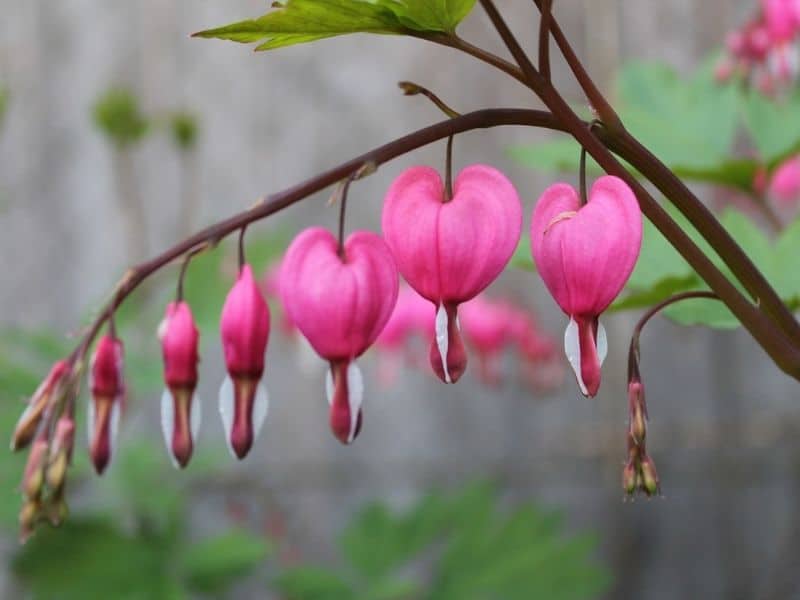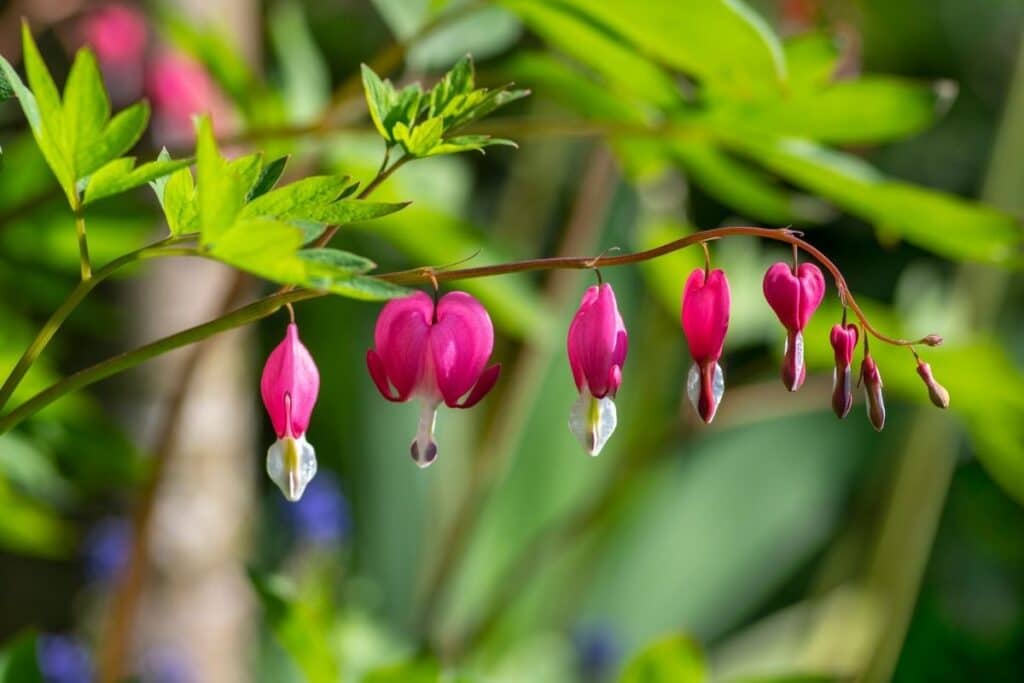Bleeding hearts are some of the most unique-looking flowers that you can grow in your own backyard! Although the bleeding heart blooms are beautiful, they have a short bloom cycle that leaves behind a large amount of foliage that is not particularly pretty in a flower garden.
Although bleeding hearts are not particularly difficult to grow, they do have some preferences that should be addressed when deciding whether to grow them around your home.
You will also want to plan out your landscaping to account for the periods of time where your bleeding hearts are not in bloom.
What are Bleeding Heart Plants?

Bleeding hearts (also known as Lamprocapnos spectabilis and Asian bleeding-heart) are unlike most other flowers growing around your home. The flowers are heart-shaped with a small trail of color that falls just below the bloom itself. These flowers are generally pink in color—similar to an actual heart—but can also be found in white.
The flowers grow and hang below arching stems in rows that jet off from the plants, making them very prominent when compared to the rest of the plant.
Bleeding hearts thrive in USDA hardiness zones three, four, five, six, seven, eight, and nine, meaning they will grow and come back year after year in these growing zones. The bleeding heart is classified as a herbaceous perennial and is a part of the poppy family.
You may have different results when it comes to blooming times in different hardiness zones. Bloom times will generally start earlier for the warmer climates and later for the cooler climates.
Regardless of the climate, the blooms will generally only last for a few weeks at a time. Taking proper care of your bleeding heart plants is the best way to ensure maximum bloom time.

How to Care for Bleeding Heart Plants
Bleeding heart plants have some ideal conditions that will keep them happy and blooming as often as possible. In general, bleeding hearts are relatively simple to take care of, but some extra help can go a long way in terms of your plant’s health.
Sun
Partial shade locations are best for many shade loving flowers including bleeding hearts, and many choose to plant them under deciduous trees which will provide shade in the months when the shade is needed. Partial shade ranges between three and six hours of direct sunlight a day, perfect for the bleeding heart plant.
Keeping your bleeding hearts in partial shade will help to keep them cool.
One of the most common problems you will encounter with a bleeding heart plant is too much heat. So, in warmer climates, shade becomes even more crucial. If your bleeding heart plants become too warm, they may stop blooming or will start to die in more extreme heat cases.
Soil
Bleeding heart plants thrive in well draining soil, but with good soil moisture management. Partially-drained soil works well for them, as it allows for some water retention while preventing waterlogging. Depending on your soil type, you may need to adjust watering frequency to maintain optimal soil moisture levels.
Bleeding heart plants also do best in nutrient-rich soil that has organic material mixed in. To add organic materials, consider things like compost or manure, and add them in by turning the soil over around the organic materials.
Turning the soil can also help to loosen it up and create a better drainage environment for your bleeding heart plants.
Water
You should plan on watering your bleeding hearts approximately once a week to ensure they are getting the water they need, especially in the warm summer months.
Although bleeding hearts are relatively drought-resistant, they are more likely to stay healthy and bloom when adequate water is supplied. If you live in a warmer climate, consider watering every couple of days in the hottest parts of summer.
Bleeding hearts do best in moist soil conditions, so you can gauge your watering from the wetness of the soil. If the ground is plenty moist from rainfall, you won’t need to bother watering. However, if the ground is dry, they could need a nice watering.
Watering your bleeding hearts when they are in their dormant stages is an important factor, too, as they are easy to overlook.
Fertilizer
Fertilizer is not always necessary for bleeding heart plants but is more likely to be needed if your soil quality is poor. If you decide to put organic materials into your soil as mentioned previously, this can act as a fertilizer and your plants will probably not need any other nutrients.
If you decide to fertilize your bleeding hearts, do so lightly. These plants do not require an abundance of nutrients, and you might shock the plant if you add too much at once. An organic, slow-release fertilizer applied once a year should be sufficient.
Pruning
The foliage on a bleeding heart plant can become overgrown, and pruning may become necessary, especially in early spring to early summer. If you decide to prune your bleeding heart’s foliage, do so lightly.
Pruning off too much at once can shock the plant and cause it to either go dormant or skip blooming for the season.
You may be able to trim off a little extra while the plant is in its dormant stages because it is less likely to be negatively affected during this time.
Many flowering plants require deadheading, which is the removal of dead flower heads. However, this is not the case for the bleeding heart flowers.
Although you can do deadheading to make the plant look a little nicer, it will not help to encourage new blooms as it does with other plants. Leaving the dead flowers is the only way you can have seeds, so if you want seeds from your bleeding heart, leave the flowers alone.

Starting Bleeding Heart Plants
If you are wanting to plant bleeding heart plants in your garden or landscaping, you have a few options on how to get them started.
Although purchasing a seedling from a nursery may be the easiest option, many find greater rewards when starting their plant from a seed or from a cutting or division of another plant.
Seeds
Growing plants from seed is traditionally one of the most common ways to acquire your plants. Bleeding heart seeds are readily available for purchase online, and can also be found in most nursery stores.
You also may be lucky enough to have a friend who can give you seeds from their own bleeding heart plant.
If growing from seed, you will need to start them from late fall to early winter, or approximately 12 weeks before the last frost date.
You will start by using a cold stratify tactic by placing them in your refrigerator for four to six weeks. Cold stratification is an important step because it mimics the natural temperature in which the bleeding heart is accustomed to germinating in.
Next, you can bring the potted seeds out of the refrigerator and set them inside a counter to grow into a seedling. Once this seedling has grown to a decent size and the timing is right, it can be planted in your desired location outdoors.
Divisions/ Cuttings
Another option you have when obtaining a bleeding heart plant is to take a division or cuttings from another plant—most likely from a friend or relative—with their permission, of course.
When dividing a bleeding heart plant, do so after the blooms have ended for the season to avoid damaging them.
Dividing the plant is the process of separating some of the roots and transplanting the separated sections in another location to grow into a whole new plant. This is a pretty safe process for the bleeding heart because they have thick roots that are easy to work with.
Cuttings work in a very similar way, but instead of dividing the root system, you simply cut a small section off.
Cuttings are generally more difficult to work with, but you may be more likely to get someone to agree to take a small cutting from their plant than you are in convincing them to separate a whole section out of their plant.
Seedlings
The easiest way to obtain a bleeding heart plant is to purchase a seedling or young plant from a nursery. A majority of these plants have been started from seed, but someone else did all of the difficult work that you now don’t have to endure.
Planting your bleeding heart seedlings is a pretty straightforward task. Just make sure you supply ample amounts of water to help the plant better establish itself once planted in the ground.
Popular Varieties of Bleeding Heart Plant You Can Grow
There are many different flower varieties to grow in your garden. When it comes to bleeding hearts, although most types look very similar (besides color differences), each variety comes with its own unique attributes.
Old Fashioned Bleeding Heart
Perhaps, one of the most popular varieties of the bleeding heart plant is the old fashioned bleeding heart. This is also the oldest variety—if you hadn’t already guessed that based on the name. The old fashioned bleeding heart grows dark pink flowers on large, bushy foliage that has deep green leaves.
The plant itself can grow to be around 30 to 36 inches tall, and you may need to do some trimming if it starts to become overgrown. This variety does not offer many variations, but it’s a classic that many have fallen in love with throughout the years.
Alba
The alba variety is one of the fastest-growing varieties and reaches heights of 24 to 30 inches when fully matured. This variety can also act as a clumping flower, spreading 18 to 36 inches horizontally. This variety is one of the best options for long horizontal growth.
The flowers of the alba variety are a bright white, and stand out nicely against their light green foliage. Many choose to plant a white and a pink variety next to each other for artistic contrast.
Gold Heart
The gold heart variety is unique in the way that its foliage is yellowish gold in color. The gold-colored foliage is a nice addition to the bleeding heart because more of the year will be spent looking at the foliage once the blooms have been spent for the season.
In a landscape of green leaves, these gold leaves will surely stand out.
The flowers of the gold heart variety are pink in color, nearly identical to the old fashioned bleeding heart variety. This plant grows between 30 and 36 inches in height once it is fully matured.
Valentine
Valentine seems like a fitting name for a variety of bleeding hearts. This variety grows deep scarlet-colored flowers that grow on equally deep red stems. Many choose this variety for these red colors, as they are not found on many other varieties.
This variety is much smaller than most of the other bleeding heart varieties. At maturity, it may only grow to be a foot tall, although they can occasionally reach two feet in height.
The flowers themselves are also slightly smaller than a traditional bleeding heart flower. Their intense red colors help them stand out—even if they are a little small.
Bleeding Heart Plant Challenges
There are some vulnerabilities that you need to look out for when it comes to your bleeding heart plants. With such short blooming windows, it is important to plan ahead for any potential problems before they cause damage to your beautiful blooms.
Heat
Heat is one of the most hazardous conditions that can affect your bleeding heart plants. Strong summer heat can cause your bleeding heart to wilt, cause stunt growth, and affect blooming if too intense.
If you live in a warmer climate, providing a nice shady location for your bleeding hearts to grow is the best way to keep them cool. Extra water in the brutally hot months can also help your bleeding hearts from becoming damaged due to excessive heat.
Aphids
Although aphid infestations are relatively common, your bleeding heart is likely to survive an attack. Aphids attach themselves to the underside of leaves while they suck the nutrients from the plant.
Luckily for the bleeding heart plant, it generally has plenty of leaves and growth to share some of its nutrients with the aphids if they do come by for a visit.
If the aphid infestation becomes too intense, you can spray the leaves with water or neem oil to get rid of them. You can also spray neem oil as a deterrent so the aphids won’t be a problem in the first place.
Fungal Diseases
There are a few fungal diseases that you need to look out for on your bleeding heart plants. Yellow spotting on the leaves can be one of the first symptoms of a fungal disease, and taking action right away can help keep your bleeding heart plant as healthy as possible.
Fusarium wilt is a common fungal disease that can form at the root base and will work its way up through the plant. This fungal disease will form if there is too much water pooling around the roots, causing a heavily wet and dark location, ideal for fungal growth.
Verticillium wilt is another common fungal disease that hits primarily on the tissues of the stem. If the stem becomes damaged from the disease, the plant may have difficulty with water and nutrient intake, which can cause the plant to die slowly or grow stunted.
The best way to handle these fungal diseases is to simply eliminate the sections of the plant that are affected. Unfortunately, if the whole plant is affected, you may have to get rid of the plant entirely.
Keeping your bleeding heart plant in its healthiest conditions is the best way to prevent any fungal diseases.
FAQs
Is the bleeding heart plant indoor or outdoor?
Bleeding heart plants are typically grown outdoors in gardens or landscapes. While they can be grown indoors in containers, they generally prefer outdoor conditions with adequate sunlight and space to spread.
Can bleeding hearts grow in pots?
Yes, bleeding hearts can grow in pots or containers, provided they have suitable growing conditions. Use a large container with well-draining soil, and ensure it receives partial to full shade, as bleeding hearts prefer cooler, shaded environments.
Can bleeding hearts take full sun?
Bleeding hearts prefer partial to full shade and can tolerate some morning sun light but generally prefer cooler, shaded conditions. Excessive sunlight, especially in hot climates, can cause their foliage to wilt or scorch.
Is the bleeding heart flower poisonous?
Yes, all parts of the bleeding heart plant, including the foliage, flowers, and roots, contain toxic compounds called alkaloids. Ingestion of these parts can cause symptoms such as nausea, vomiting, and diarrhea. It’s essential to handle bleeding hearts with care and keep them out of reach of children and pets.
Can bleeding hearts be cut back after blooming?
Yes, bleeding hearts can be cut back after blooming to promote new growth and maintain the plant’s appearance. Remove spent flower stalks and trim back any yellowing or dead foliage. However, avoid cutting back the entire plant, as it may diminish its vigor and flowering the following year.
Up next: Bleeding Heart Flower Meaning and Symbolism
*image by depositphotos.com/ivusakzkrabice







